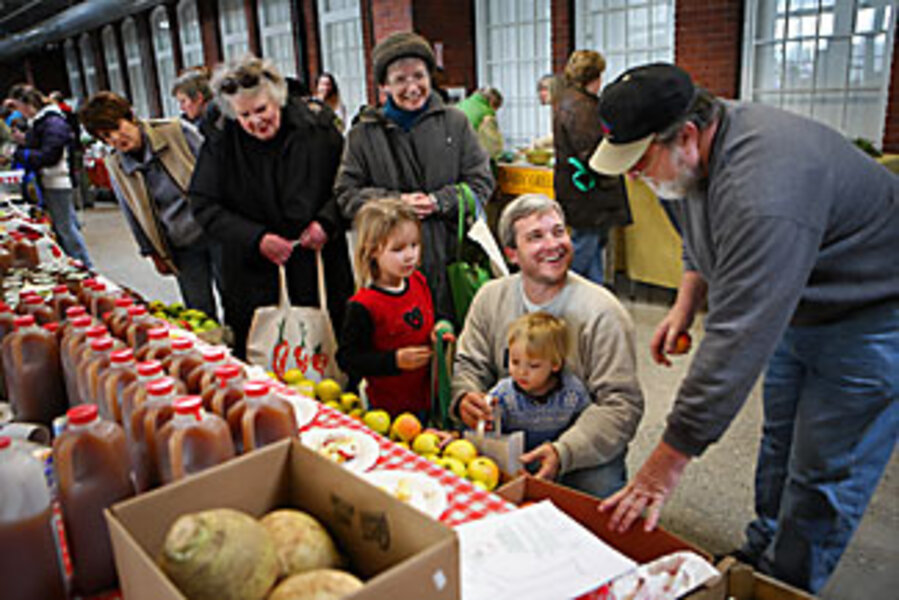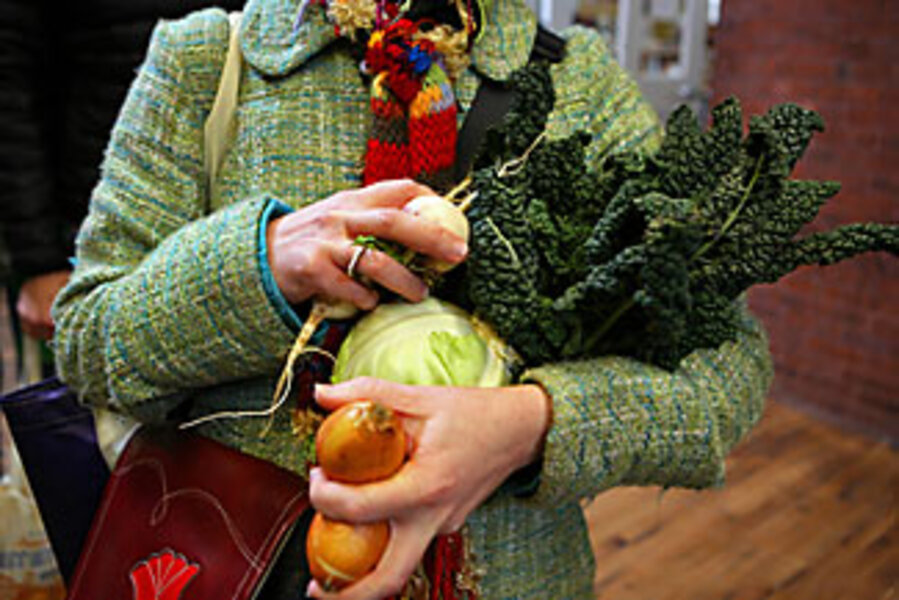Eat local – even in winter
Loading...
| Pawtucket, R.I.
Inside a long corridor of a renovated mill on a cold January morning, a young brown-haired woman slices handmade ricotta and feta cheeses and lays them out on wooden cheese boards. Around her, baskets of fresh bread and homemade pies line rows of tables and locally harvested oysters poke through clusters of ice.
Although ice and snow cover the sidewalks outside, the cheerful sounds of a string band warm the makeshift marketplace in Hope Artiste Village in Pawtucket, R.I.
The scene at the Rhode Island Wintertime Farmers' Market is not unlike those found in towns and villages across the country each spring and summer. What's unusual here and in growing numbers of communities is what was once small and seasonal is now bigger and year-round, a response to the growing demand nationwide for locally grown and locally produced foods.
The movement has spawned a word – locavore – applied to people who try to eat food grown or produced within a 100-mile radius or less to help decrease their environmental impact and support their local economy.
But it goes beyond those who are committed to buying locally to include those who simply want to eat fresh food.
This desire is one of the main reasons farmers' markets are increasing, up some 300 in the two years between August 2006 and 2008, as the total number surpassed 4,500 according to the US Department of Agriculture. And it's helping sustain about 750 farmers' markets that operate between the months of November and March.
The search for local food is what brought Kathrine Lovell and Carmen Grinkis of Barrington, R.I., to the Rhode Island Wintertime Farmers' Market.
"This is keeping us going through winter until we can start growing stuff," says Ms. Lovell, whose reusable shopping bag was filled with short ribs and a pork pie.
In Rhode Island, farmers have been gathering every Saturday since December 2007 to sell winter produce they grow in greenhouses or keep in storage. From December to April, shoppers can purchase fresh produce, live lobsters, baked goods, and grass-fed beef, among other items.
Shopping at a winter farmers' market is different from shopping in the summer. The hours may fluctuate, the weather is colder, and people should be prepared to "not expect the same things you would expect in a grocery store," says Stacy Miller, executive director for the Farmers Market Coalition, a nonprofit organization that helps sustain farmers' markets.
Although the ripe bounty may look and taste different – you won't find juicy strawberries or peaches – there's still plenty of winter produce to pick through and taste.
That said, shopping at a winter farmers' market requires creativity and the willingness to try some vegetables many people don't naturally savor.
Winter standbys include beets, winter squash, potatoes, onions, kale, cabbage, and parsnips. Some may carry a certain connotation, Ms. Miller says, but don't let these crops intimidate you.
"One of the big things is to really listen to the farmers and ask them questions," says Miller. "If [the farmers] don't love it, and they haven't found a way to cook it and make it delicious, they wouldn't bother growing it."
Thoughtful eating
Buying locally grown produce has changed the way Ms. Grinski and Lovell prepare meals. "It made me really think about what I was eating," says Lovell.
Now, they no longer shop at big-box stores, opting to ride their scooters to the local market instead. Year-round, they purchase eggs from a farmer nearby, and fruits, vegetables, and prepared foods at farmers' markets.
"You don't feel attached to [your food]" at the supermarket," says Lovell.
Or to the people selling it. At the market, Grinski says, "you engage with people. You have a connection to the land."
Eating local is often perceived to be more expensive and sometimes it is because specialty items such as jams or artisan cheeses are labor intensive, says Dawn Thilmany, a professor of agricultural and resource economics at Colorado State University in Fort Collins, who has studied consumers' motivations to purchase local produce.
But at other times, she adds, it's possible to find deals on local foods.
Still, Ms. Thilmany and her colleagues found in a survey of 1,500 consumers nationwide that 30 percent shop at farmers' markets or buy from farm producers and that these consumers will pay anywhere from 7 to 23 percent more for local, organic, or what they consider nutritionally superior products.
Even in these hard economic times, the slightly higher costs don't seem to have scared away customers.
In Muskegon, Mich., the Sweetwater Local Foods Market expanded to 12-month operations in November 2006. It sells local, organic products every other Saturday, moving indoors from October to March. The winter markets are "as big as our best summer markets," manager Diana Jancek says.
Year-round markets can be found in urban areas such as Washington, D.C. Every Sunday, 28 vendors sell produce, flowers, meats, and more outside at the FRESHFARM Market on Dupont Circle.
The market has grown since adopting a year-round schedule in 2003. At the first wintertime market in January this year, 1,400 people showed up and the vegetable producers just about sold out, says the codirector, Ann Yonkers.
Still, drawing people to a winter farmers' market isn't always easy, so organizers in various areas are finding creative ways to draw customers.
In Rhode Island, chefs from Johnson & Wales University in Providence host cooking demonstrations using local ingredients. Vendors at the Sweetwater Local Foods Market give away selected products to shoppers every week and bring in local bands.
In the Midwest, the organization Churches' Center for Land and People, which hosts traveling winter markets in Illinois and Wisconsin, donates 10 percent of sales to the Harvest of Hope foundation, which provides financial assistance to farmers and their families. At the beginning or end of each market, the organizing congregation also serves a meal prepared with local ingredients.
Fliers, a website with a directory of local vendors, and word of mouth have contributed to the success of the Rhode Island Wintertime Farmers' Market.
But what ultimately works best is shoppers' interest in fresh food, says Noah Fulmer, the executive director and cofounder of Fresh Farm Rhode Island, the nonprofit that organizes the market.
Getting to know the farmers
"I think what people are turning to now is reconnecting with the producers of the food and getting food that is grown for its flavor and grown for its nutrition," he says.
Harder times also may mean more home cooking, another reason Brian Simmons, owner of Simmons Farm in Middletown, R.I., thinks the market has been so successful.
"Overall, the local food scene has been growing," says Mr. Simmons, standing behind coolers full of grass-fed, organic beef, pork sausages, and bacon. The market has allowed him to quadruple his winter income by selling directly to customers rather than to stores.
As this day's market winds down and vendors start packing up their things, Grinski and Lovell walk through the tables with one more purchase that's been added to their shopping bag: freshly caught scallops.
It's precisely such market "catches" that, Lovell says, have made her enjoy cooking that much more.






